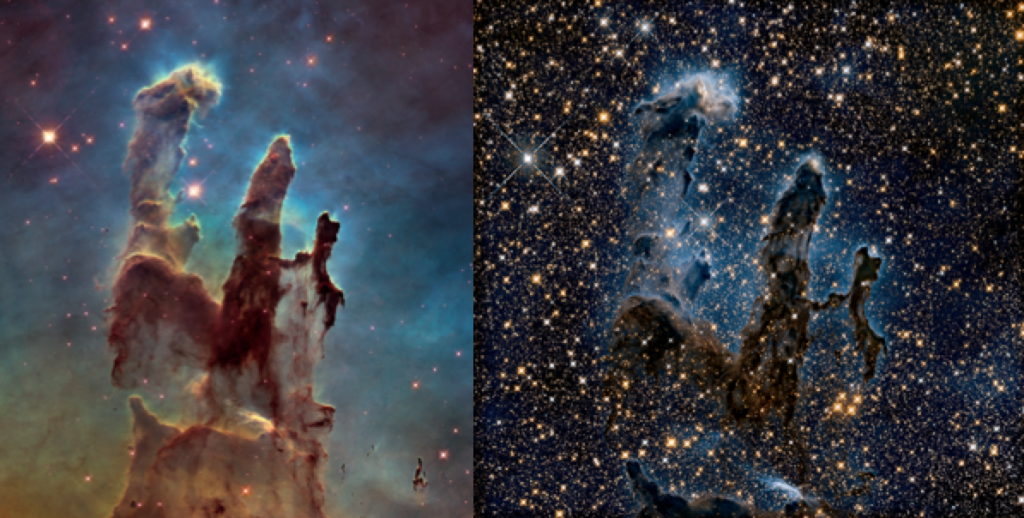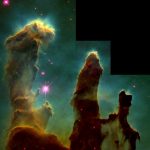

One of the most famous Hubble images is a view of the Eagl![]() e Nebula dubbed “The Pillars of Creation.” Originally produced in 1995, the view showed details of three columns of gas, as NASA’s website put it, “bathed in the scorching ultraviolet light from a cluster of young, massive stars in a small region of the Eagle Nebula, or M16.” This iconic image of the wonders of Hubble exploration appeared on tee shirts and pillows, and even a postage stamp.[footnote]“Hubble Goes High Def to Revisit the Iconic ‘Pillars of Creation,’ January 5, 2015. http://hubblesite.org/news_release/news/2015-01/110-american-astronomical-society-meeting. Accessed February 16, 2017.[/footnote]
e Nebula dubbed “The Pillars of Creation.” Originally produced in 1995, the view showed details of three columns of gas, as NASA’s website put it, “bathed in the scorching ultraviolet light from a cluster of young, massive stars in a small region of the Eagle Nebula, or M16.” This iconic image of the wonders of Hubble exploration appeared on tee shirts and pillows, and even a postage stamp.[footnote]“Hubble Goes High Def to Revisit the Iconic ‘Pillars of Creation,’ January 5, 2015. http://hubblesite.org/news_release/news/2015-01/110-american-astronomical-society-meeting. Accessed February 16, 2017.[/footnote]
To celebrate the 25th anniversary of the telescope, Hubble revisited the site, sending back data for sharper and broader images. Photographed in both visible and near-infrared light, the pillars appear as evanescent shapes containing newborn stars. As astronomers pieced together the exposures, they were amazed by the detail that was visible for the first time.
Astronomer Paul Scowen of Arizona State University at Tempe observed of the new images: “There is only one thing that can light up a neighborhood like this: massive stars kicking out enough horsepower in ultraviolet light to ionize the gas clouds and make them glow. Nebulous star-forming regions like M16 are the insterstellar neon signs that say ‘We just made a bunch of massive stars here.’ “[footnote]Hubble Goes High Def to Revisit the Iconic ‘Pillars of Creation,’ January 5, 2015. http://hubblesite.org/news_release/news/2015-01/110-american-astronomical-society-meeting. Accessed Feburary 16, 2017.[/footnote]
Several different Hubble exposures were combined to create the 2014 visible light view. The Hubble website explains, “Streamers of gas can be seen bleeding off the pillars as the intense radiation heats and evaporates it into space. Denser regions of the pillars are shadowing material beneath them from the powerful radiation. Stars are being born deep inside the pillars, which are made of cold hydrogen gas laced with dust. The pillars are part of a small region of the Eagle Nebula, a vast star-forming region 6,500 light-years from Earth. The colors in the image highlight emission from several chemical elements. Oxygen emission is blue, sulfur is orange, and hydrogen and nitrogen are green.”[footnote]“2014 Hubble WFC3/UVIS Image of M16,” January 5, 2015. http://hubblesite.org/image/3471/news/91-astronomical. Accessed February 16, 2017.[/footnote]The near-infrared view reveals newly formed stars behind the nebula and inside the pillars not seen in the visible light image.
View this public domain “Hubblecast” to learn more about the photograph:
https://vimeo.com/204394047